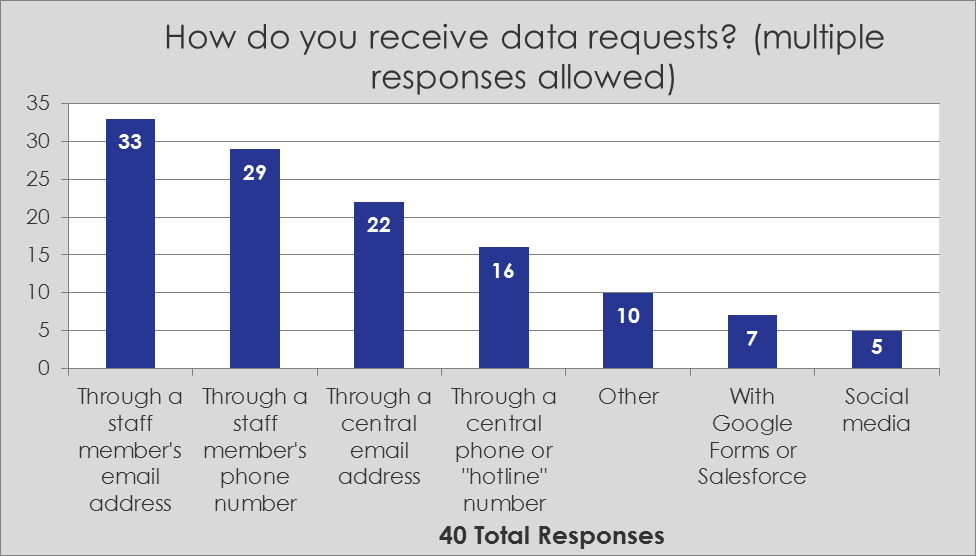How do partners receive and track requests?
NNIP partners with existing data request systems have several ways of collecting and tracking requests.
Receiving Requests
Over 80 percent of NNIP partners handle data requests by receiving them through a staff member’s email, and 73 percent of partners use a staff member’s phone number. While this method is common, and often inevitable, taking requests by an individual’s email or phone can be difficult to keep track of. Just over half of partners use a central email address or phone number, which is easier to track and promotes accountability. You can read more about our best practices, including streamlining intake and promoting accountability within the team, in a presentation by Jake Cowan and Allison Plyer on Delivering Technical Assistance.

A couple of partners get help desk requests from community meetings or by word of mouth, but we find that while this helps build relationships, it is hard to derive insights from or measure influence by this process. Some partners even use social media, which helps users and can promote partners’ brands. While 15 percent of partners use Google Forms, like the Urban Strategies Council in Oakland, most organizations who responded “other” used some other type of form-based application. Form-based applications are the most helpful for collecting information, and can be used to track outcomes.
Example of Google Forms from the New Orleans Partner, Data Center:

For more examples, see the websites of DC partner NeighborhoodInfo DC, and Seattle partner Public Health of Seattle and King County.
Tracking Requests
Tracking questions is the best way to measure the success of a help desk, and tracking has numerous benefits to NNIP partners. All but three NNIP Partner organizations track their incoming requests. The best way to track responses is to input TA requests into a TA knowledge management system. The guide Monitoring Impact, by Jake Cowan and Tom Kingsley, goes into detail on the streamlined process of maintaining accountability in help desk management. First there is an initial email notification to the team, ownership of the request, an initial response, and a crafted response can be carried out to complete the request. When tracking data requests nearly all partners record the name and organization of the requester, but less than half of partners record the answer to the question. Only 60 percent of NNIP partner organizations record the response date or the staff member who handled the request. We suggest that the intake fields include the following key pieces of information:
- Name, Title, Organization, Email Address, Phone
- Whom does your organization serve?
- What data do you need?
- What do you plan to do with this data: (What are you trying to demonstrate? Or what is your research question?)
- What information sources have you already looked at?
- Date you need the data (2 weeks or more lead time required to fulfill requests)
Tracking information--such as purpose of the request and location--can help develop a well-designed and functional help desk, and can often benefit in other ways long after the question has been answered.
Most partner organizations track data requests through a shared document or spreadsheet, and many partners have informal ways of tracking data requests. Only three partner organizations said that they do not track data requests at all. Tracking these requests can prove extremely useful in demonstrating community need, writing grants, and evaluating partners’ website functionality. The Furman Center uses SalesForce, which is free for non-profit organizations, to track requests. Additionally, tracking data requests can contribute to closing reports, which should include who responded to the TA request, the date it was completed, the type of organization requesting data, the intended use, the service provided, and the amount of time spent with the request.
Following up with users can also provide insights that can contribute to a thorough closing report. However, only about one-quarter of partner organizations follow up with the requester of the data to find out if they were satisfied or what they did with the information. Four NNIP partners follow up with the data requester through a formal survey, and four use informal means, while the rest do not follow up at all. Following up on a data request can help partners demonstrate and understand the services they provide to the community. This is also valuable for obtaining and for keeping funding. Section 4 of the Monitoring Impact guide provides examples on how to implement informal or formal surveys, both of which can be helpful for managing help desks. You can also skip to our Performance Management Best Practices section at the end of this guide to read more about how to track help desk success.
Using statistics on how many questions an organization receives is an excellent way to show that an NNIP Organization is an invaluable asset to the community. These statistics can be used in grants and proposals, and a help desk can be a relatively small investment for a payoff down the line. A data help desk can also demonstrate need by telling a story of how a partner’s data helped the community. This story can also go into grants, proposals, and websites. Following through on the quality of their customer service and ensuring that their data are used correctly will help partners get the most out of the their investment in collecting, processing, and publishing data.
Example of Marketo Marketing & Lead Management for tracking requests:

